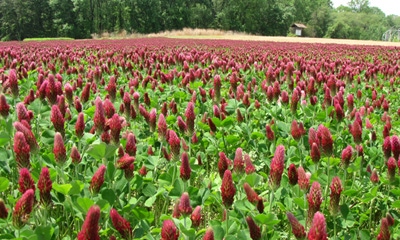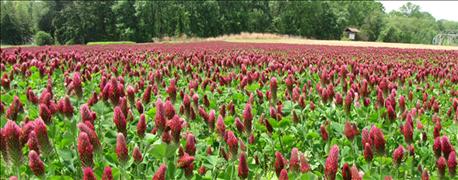
You can create a buffet for the microorganisms in your fields if you grow wheat. It starts after the wheat comes off the field. Farmers south of Interstate 70 traditionally plant soybeans after wheat. That was tough last year due to too much rain. And it is tough most years as you move farther north in Indiana, since you run out of growing season before double-crop soybeans mature.

MORE OPTIONS: Crimson clover is an option if you can plant in late summer or early fall, say after summer wheat harvest. This clover was allowed to bloom before being knocked down in the spring. (Photo courtesy of the Natural Resources Conservation Service)
Shannon Zezula, resource conservationist with the Natural Resources Conservation Service, along with other NRCS staff members around the state and the Indiana Conservation Partners, put together information to explain another alternative to planting soybeans after wheat, especially where that practice doesn’t fit as well.
Farmers who plant wheat have a great opportunity to improve the health of their soils, Zezula says. With wheat coming off in late June or July, there is a vast list of cover crops that can be planted.
The problem with some cover crops is that they do better when seeded relatively early in late summer than if planted after corn or soybean harvest. Annual ryegrass is on that list. In fact, cereal rye is about the only cover crop that can be planted throughout October and into early November with reasonably good chances of having success. Most don’t get enough growth in the fall if planted too late, and often don’t perform well in the spring if that occurs.
This is a great opportunity to choose from a full suite of cover crop options and mixes. The saying is, “Diversity above ground equals diversity below ground.” Choose a mix of cover crops that have different rooting types, such as fibrous roots or taproots, which work at varying depths. For example, annual ryegrass has fibrous roots, but radishes and turnips have taproots.
The different rooting depths will improve the distribution of organic matter, enhance your biology underground, and increase your soils' water- and nutrient-holding capacity. For more information, contact your local NRCS office at nrcs.usda.gov.
About the Author(s)
You May Also Like




